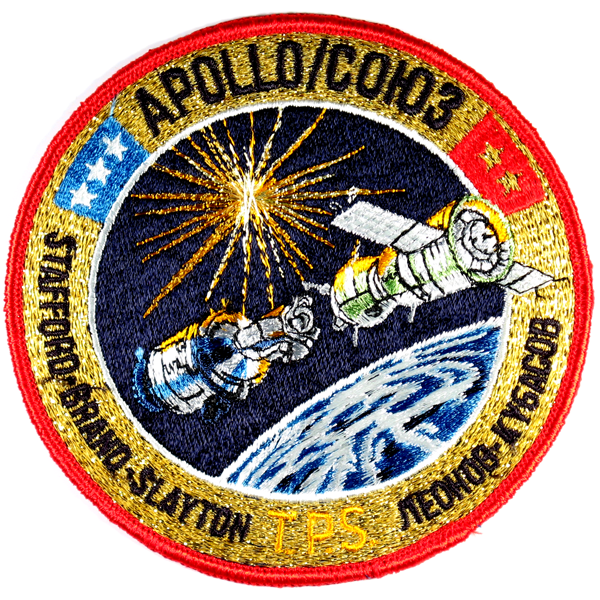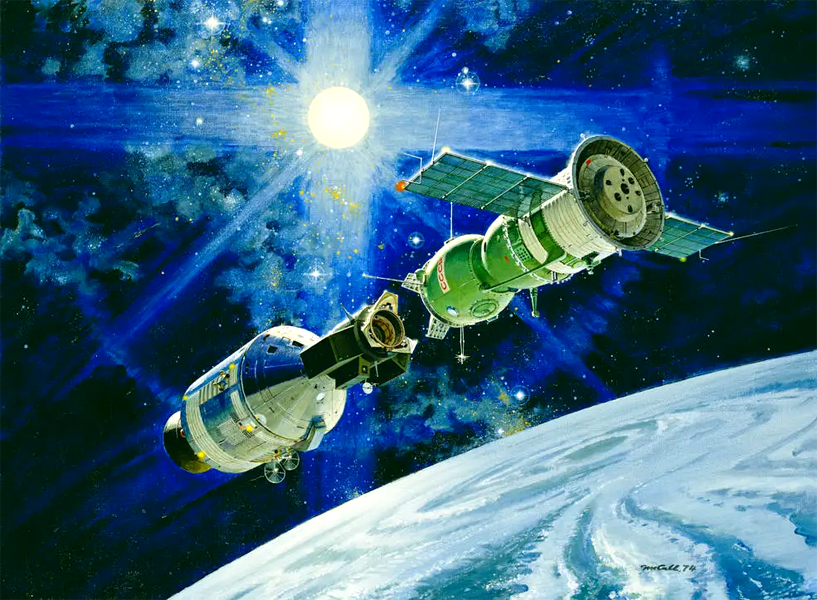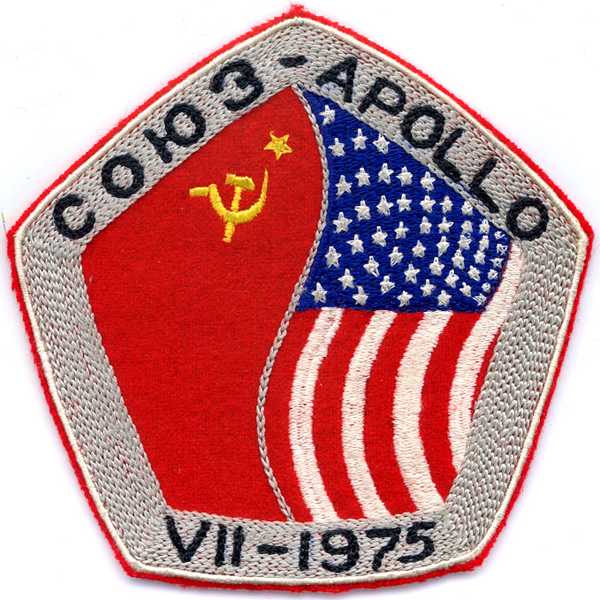

Thomas Stafford
Vance Brand
Donald “Deke” Slayton
Alexei Leonov
Valeri Kubasov
Jean Pinataro

This is the official American crew patch for the Apollo-Soyuz flight, though the Soviet crew also wore this patch on the flight. The Soviet crew had their own patch which they wore in addition.
The ASTP patch was designed by Jean Pinataro of North American Rockwell,
the prime contractor for the Apollo CSM. It was selected by the crew from
an industry-wide competition. Pinataro’s initial version of the ASTP patch
(shown at left)
 was submitted by JSC Director Chris Kraft for approval in May 1974, but
was disapproved by NASA Headquarters, with the explanation that “since
this is a significant international project ... perhaps a patch depicting
more of the international significance might merit further
consideration.” In mid-June the same patch, without change, was
again submitted by Kraft, stating that while the crew had reconsidered
the design, they felt that it did, in fact, reflect the international flavor
of the flight.
was submitted by JSC Director Chris Kraft for approval in May 1974, but
was disapproved by NASA Headquarters, with the explanation that “since
this is a significant international project ... perhaps a patch depicting
more of the international significance might merit further
consideration.” In mid-June the same patch, without change, was
again submitted by Kraft, stating that while the crew had reconsidered
the design, they felt that it did, in fact, reflect the international flavor
of the flight.
In August, the design was firmly refused, with an offer “to provide funds from the NASA Artist Program for the crew to engage an artist of their choice to help develop a suitable design.”
Under quite restrictive direction from the astronaut office, Pinataro re-designed the patch, with a central vignette derived from Robert McCall’s 1974 painting of the subject. Notably absent from the design is McCall’s signature “cross” sunburst, which was removed due to concerns that it could be percieved as a religious symbol. She recalls: “[the crew] called all the shots on it, like how large to make the vehicles, where to put the sun, and how far the rays should extend, definitely not to the earth, etc. I recall being annoyed that the astronaut’s directions were so explicit that I was unable to connect the three elements in that central area.” In December this significantly re-designed image was submitted for approval, which was finally granted.
The expression of reasons for disapproval of the first design as communicated to the crew were particularly vague. I suspect this was intentional, and that the real reasons were withheld from the crew due to their close working relationship with the Soviet crew. Behind the scenes the real objections were that the design was “cartoonish,” pointing out the stars on the flags: on the American flag the stars were not uniform in size and placement, and on the Soviet side there were two stars (there was actually only one on the Soviet flag); and that the Soyuz spacecraft is made to look larger than the Apollo, when in fact it is smaller. Such petty considerations are the domain of politics, and this was an entirely political endeavor. The final, approved version of the patch had many design elements in common with the first — the biggest change being the removal of the national flag motifs. The Soyuz is still portrayed in a way that makes it seem at least equal in size to the Apollo spacecraft, but this can be explained away as a matter of perspective. Not to mention the fact that this was a virtual copy of an image that had already seen widespread dissemination — making it difficult to object to. Personally, I find it rather amusing to observe that the Soviet crew patch is based on the flag design elements that were removed from the American patch.
“APOLLO” and the American astronaut names appear in Latin script, while “СОЮЗ” (SOYUZ) and the cosmonaut names appear in Cyrillic. The 3 stars in the blue field, and the 2 stars in the red field, represent the American and Soviet crews, respectively.

[apso-em1]
AB Emblem embroidered Apollo-Soyuz crew patch. The gold
border on this patch has metallic threads.
103mm dia

[apso-em2dks]
A special AB Emblem embroidered Apollo-Soyuz crew patch.
Apparently a set of these 4½″ patches was made for
the American ASTP crew, similar to those made for Apollo
17. This one has Stafford’s initials, “TPS”, embroidered
in yellow thread at the bottom of the patch. The patches for Slayton carry
the initials DKS, and those for Brand have VDB. Apparently a
small number were also made for the Soviet crew, with the initials
ААЛ for Leonov, and ВНК for Kubasov.

[apso-aw2]
This sketch was produced by Pinataro after her original design was rejected
twice by NASA Headquarters. The central vignette is so conceptually
close to the final design it’s surprising that this version
was rejected. I suspect the hammer-and-sickle motif at the bottom
was simply deemed unacceptable. Courtesy of the University of Houston at
Clear Lake JSC Archives.

[apso-aa1]
The painting by Robert McCall which was used
for the central image of the final ASTP patch. The cross-like
rays from the sun were eliminated, due to concern that they might be
construed as having religious overtones.
Up until the time of this flight, Soviet missions did not have crew patches. While Valentina Tereshkova did have an embroidered dove sewn to the coveralls worn under her pressure suit, it was not Tereshkova’s idea nor design. As such, it clearly was not a “crew patch.” There was the occassional patch worn in the intervening years, such as the blue diamond CCCP on Alexei Leonov’s EVA suit during his spacewalk on Voskhod 2, but these were more-or-less the equivalent of the NASA emblem worn by all astronauts beginning with Alan Shepard’s Mercury flight.
When the American ASTP crew designed their patch, there was some angst about whether to include the cosmonauts names on the patch: would they feel snubbed if not included? Perhaps they would have their own patch? In the end, the cosmonaut names were included and they would have their own patch. But since the Americans included the cosmonauts names on their crew patch, the cosmonauts didn’t want to offend by not wearing that patch — so they ended up wearing both patches.

NASA Photo AST-5-305.
In their eagerness to avoid causing offense, the cosmonauts
were positively festooned with patches. This photo of Valeriy Kubasov
during flight shows him with two mission patches — one of American
design, and one of Soviet — as well as a Soviet crest and flag.

[soap-em1]
An original Soviet crew patch. It appears that this patch
consisted of a base of red felt, with the remaining colors embroidered on
that base. “VII-1975” at the bottom refers to the date of the flight, July
1975. Aleksandr Glushko identifies “V. F. Knor” as the designer.
My thanks to Luc van den Abeelen for this image.